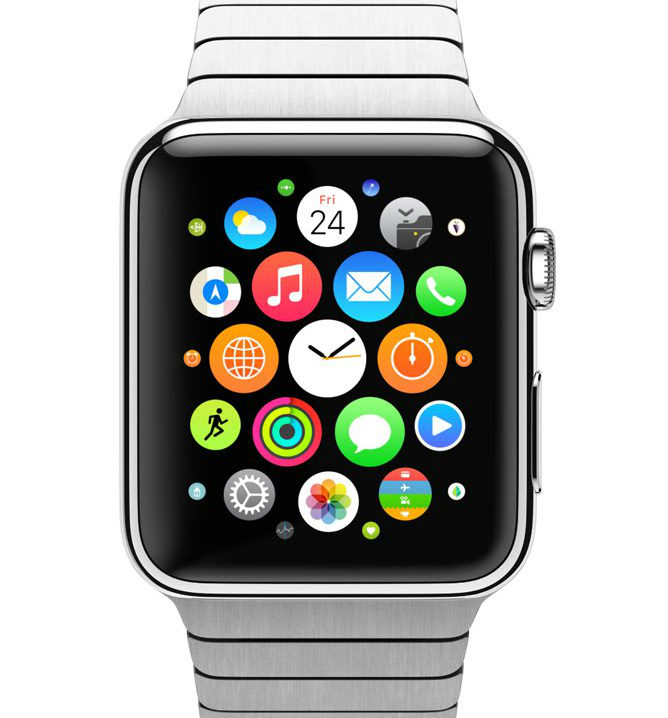- Doctors can use the Apple watch to send and receive messages, receive notifications of various types, and manage communications with colleagues, all in a HIPAA-compliant manner.
- Messages sent via the Apple watch will not automatically integrate into patients’ electronic medical records.
- Wrist watches are dirty and increase infection risk. In one study, the use of a wrist watch was associated with an enhanced total bacterial count on hands compared to hands without a watch (P <0.001).
The Apple watch (Figure) became available on April 10, according to Apple.com. Will physicians find important new ways to use this technology? From a professional perspective, you have to ask, can you use an Apple watch to improve patient outcomes, facilitate your practice, or increase your income
From the personal perspective, you might be the sort who loves any new technology and you’re already in line at the Apple store — and you still own a Betamax. Maybe you just love watches. Prices will range from about $550 to more than $17000 for the gold version.

From a professional perspective, you have to ask, can you use an Apple watch to improve patient outcomes, facilitate your practice, or increase your income?
In the days before the launch of this potentially revolutionary new device and its related software, the answers to these questions are not clear. The Apple watch may be a cool gadget, but will it be good for medicine?
Doximity
There are a number of reasons that the Apple watch could be attractive to physicians. According PR Newswire, Doximity has released an app that can enable doctors to use the watch to communicate with one another quickly and securely across institutional and national borders. Hands-Free
Health Insurance Portability and Accountability Act (HIPAA) regulations forbid physicians from using email or text messaging to communicate about patient issues. In some cases, fax, phone, and pager are simply not fast enough. The Apple watch and its various apps may be able to solve these communications problems by providing a HIPAA-secure and compliant way for doctors to communicate — hands-free.
Pros and Cons
Advocates for Apple, Doximity, and others in this market space contend that the Apple watch provides a number of potentially useful services for physicians:
- Doctors can use the watch to send and receive messages, receive notifications of various types, and manage communications with colleagues, all in a HIPAA-compliant manner.
- Using the Doximity app, physicians may be able to read previews or full messages sent from other physicians and dictate responses. For more detailed replies or to add secure medical images, the communication can be transferred another device.
- According to one study, hundreds of thousands of Americans are injured each year as a result of errors that occur when patients transfer from one context of care to another, change physicians, or when physicians change shifts. In these cases the newer doctor may not know the patient’s full history, creating significant opportunity for errors.
- Some researchers have proposed that better communication among staff could prevent as many as one-third of this type of error. The Apple watch may be able to facilitate this communication.
On the other hand (pardon the pun), the Apple watch may not be an optimal device for physicians.
- According a study published in 2011, wrist watches, rings, fingernails longer than 2mm, fingernail polish, and other types of hand adornments have been linked with increased infection rates.
- In this study, the use of a wrist watch was associated with an enhanced total bacterial count on hands compared to hands without a watch (P <0·001). The use of one plain ring finger increased the carriage rate of Enterobacteriaceae (P=0.003). A dirty wrist was observed in 90% of those who wore a watch, in 92.7% of those wearing a bracelet.
- With regard to information, messages sent via the Apple watch will not automatically integrate into patients’ electronic medical records, which could lead to the loss of data.
Questions Remain
The Health Insurance Portability and Accountability Act has long forced physicians to use fax machines and pagers to communicate with one another. This was required in order to protect patients’ privacy. Personal email and text messages are not secure enough to be HIPAA compliant.
“Is this simply a slightly more convenient [and secure] way of texting?” asked Robert Wachter, MD. Dr. Wachter is Professor and Associate Chair of the Department of Medicine at the University of California, San Francisco. He recently published the book “The Digital Doctor: Hope, Hype, and Harm at the Dawn of Medicine’s Computer Age.”
As with any new technology, it is unclear how many physicians will use the Apple watch and its apps. Will this become the next iPhone or the next Betamax?
